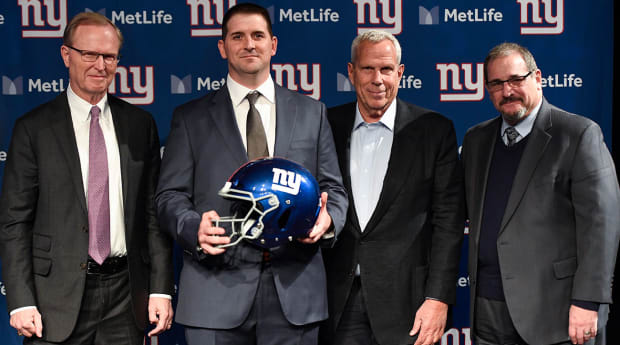Every team wants to nail the draft, but a few like the Giants and Falcons are facing a particularly crucial make-or-break kind of week.
This is an unfortunate time for a draft to be one of consequence for a general manager. Don’t get us wrong, every draft is consequential in some way if you’re the person in charge. But for personnel executives in the NFL, there often comes a turning point or a watershed moment when your previous body of work can be fairly evaluated and used as a foundation to judge an upcoming season.
We are living in unprecedented times and the NFL is forging ahead with a draft even though some of the best players cannot clearly assure teams of their medical status. Dave Gettleman cannot, as he so eloquently put it, smell the prospects. The margin for error is theoretically bigger than it was before, even if bad picks are made every season for myriad reasons.
That said, who has the most at stake in two weeks?

1. New York Giants
Throughout the latter portion of the Jerry Reese era, the team’s draft record was held up and scrutinized (rightfully so). The comeback was always that the Giants were so consistently picking in the latter half of the first round that it’s difficult to land the kind of restorative talent that other teams do when they sustain a significant losing season and end up close to the top pick. Now the narrative has changed. Gettleman, tasked with clearing out the overgrowth of bad contracts, has also overseen two foundational drafts in 2018 and 2019. Thanks to one trade up last year, Gettleman has made the second, sixth, 17th, 30th and 34th picks in the draft during his tenure and currently owns the fourth overall pick in the upcoming draft. While his penchant for needling the media, his old-fashioned leanings and (in my opinion) hollow, good-natured jabs at the analytics community give him a bad rap, he does have an eye for talent and a vision for what he wants the team to become. Is it a versatile, modern unit befitting of Joe Judge’s wishes? We’ll see. Either way, it would be difficult to keep the current personnel power structure in place if the Giants don’t soon turn the corner with their stable of high picks playing a starring role.
Where they should go/where they will go: I had Clemson LB Isaiah Simmons
mocked to the Giants, though I feel that was wishful thinking. In that scenario, Gettleman also traded back, which he has never done at the helm of any draft. Offensive line would be the on-brand maneuver here and also makes sense given Gettleman’s not-so-secret roster building philosophy of strengthening the lines. This is a solid offensive line class and Gettleman will have his pick of the best.2. Atlanta Falcons
Since 2012, the Falcons have only had two top 10 picks—Vic Beasley and Jake Matthews. Still, Thomas Dimitroff and Co. have come away with some solid talent. I would argue that Dimitroff’s performance in the second round and beyond is above average for a general manager based on how many of those picks are still in the league, regardless of whether or not they play for the Falcons. We tend to view success in the middle rounds as unearthing someone like Richard Sherman, when in reality, finding someone who could contribute throughout the life of their rookie deal and add a net positive value to the team is a better overall guideline. Still, there is no doubt that the current power structure was reeling until a late-season push saved those in charge. That’s why it will be critical for the Falcons to find a tipping point player in this draft despite picking 16th—or trading up.
Where they should go/where they will go: It would be difficult to imagine the Falcons passing up a good cornerback. It makes the 2018 selection of Calvin Ridley, which seemed like a bit of a luxury at the time, more sensible now given that they won’t be desperate to provide Matt Ryan and Julio Jones with more help. I had Jaylon Johnson going there, though C.J. Henderson also makes some sense.
3. Detroit Lions
This was an easy team to put on this list, given that ownership essentially stated its playoff expectations ahead of time. The second part of the story is that the Lions are in a unique position to improve their odds should there be a push for the second quarterback in the draft. In both my mock draft and Jenny Vrentas’s most recent mock, we have someone trading up into the top four to get Justin Herbert. This would make sense given that both the Dolphins and Chargers are theoretically hoping to land their passer of the future. If both have the same preference, it would make sense that they would move up as high as possible to ensure they are not leapfrogged by the other. That puts Detroit, with the third overall pick, in a position of power.
Would it be a disappointment to have them stay put and sit on the best cornerback available? No, especially given the chaotic circumstances of this coming draft. Would a team that needs far more than one cornerback to improve enough to make the playoffs in a difficult division be better suited dealing back? Absolutely.
Where they should go/where they will go: In a perfect, Kevin-Costner-in-Draft-Day scenario, the Lions move back and help themselves at both offensive line and wide receiver, as most of their weapons are set to hit the open market in 2021. Standing pat to take Jeffrey Okudah makes sense and would fill their most immediate need, but would that truly maximize their position?
4. Miami Dolphins
Brian Flores’s coaching performance last year was seriously underrated. So this isn’t to suggest that, should the Dolphins flounder this year the current power structure will be in trouble, but it is shining a light on the importance of this particular draft. It would be difficult to see the Dolphins stand pat with their three first-round picks (5, 18, 26) but the tentacles of this stockpile could stretch out for two or three years of critical roster building. At some point, as Browns fans know too well, there comes a pressure to shift the methodical build to an immediate payoff and when that moment occurs the Dolphins need to be ready.
Where they should go/where they will go: With some momentum behind the theory that the Dolphins may not take a quarterback, this draft could go from relatively boilerplate to chaotic in a heartbeat. The Dolphins need pass rushing help, a running back and offensive line help. They could get all of that in no particular order should they decide to wait on their quarterback of the future. Imagine, say, the best or second best offensive tackle on the board, followed by an EDGE at 18 and a running back at 26, then taking a stab at a developmental QB prospect in Round 2, which would not preclude them from going all in on Trevor Lawrence the following season.
5. Minnesota Vikings
By trading Stefon Diggs, the Vikings accumulated a second first-rounder, which is an essential lifeline for a cash-strapped club that has been teetering on the brink of Super Bowl contention for a few years now. Picking at 22 and 25, they have enough equity to move up for a playmaking wide receiver, to stand pat and let the middling portion of the EDGE rush class come to them or possibly catch the tail end of the offensive line run. This feels like the kind of opportunity that could either lift the Vikings above the fray or prevent them from breaking out of their ever-crowded division.
Where they should go/where they will go: It hasn’t always been easy for the Vikings to break in wide receiver talent, but with a quarterback signed long-term and some steadiness on their offensive line, it would make sense to try and find a Day 1 option alongside Adam Thielen. Of course, Mike Zimmer will probably push for edge rushing pieces to bolster his defense.
• Question or comment? Email us at talkback@themmqb.com.

0 Comments:
Post a Comment